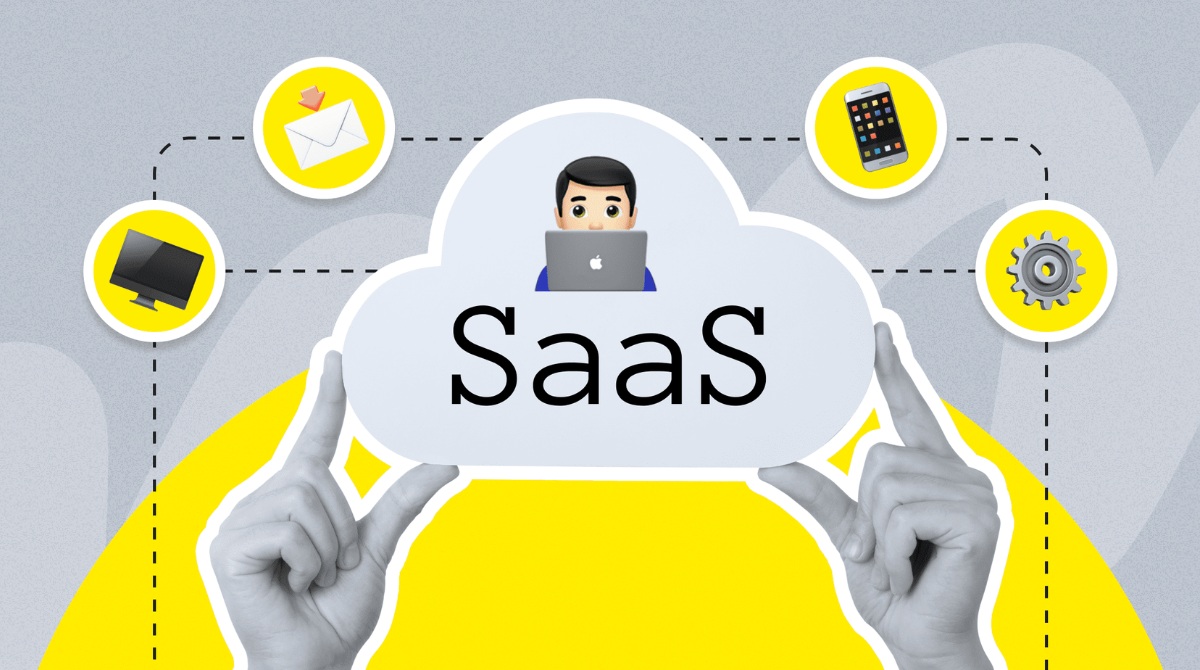Introduction
Welcome to the world of Software as a Service (SaaS) conversion rates! As a SaaS provider, you understand the importance of converting website visitors into paying customers. But what exactly is a good SaaS conversion rate? And how can you improve yours? In this article, we will delve into the realm of SaaS conversion rates and explore the factors that can impact their success.
Conversion rates are a key metric for any SaaS business. They measure the percentage of website visitors who take the desired action, such as signing up for a free trial or purchasing a subscription. A high conversion rate indicates that your marketing efforts are effective in attracting and persuading potential customers to take action.
Understanding SaaS conversion rates goes beyond just looking at the numbers. It requires analyzing the various factors that can influence these rates. A combination of elements, including the design of your website, the clarity of your value proposition, the quality of your content, and the effectiveness of your call-to-action buttons, can all impact how well your website converts visitors.
It’s important to note that there is no one-size-fits-all answer to what constitutes a good SaaS conversion rate. The ideal rate will vary depending on factors such as industry, target audience, pricing model, and stage of business growth. However, industry benchmarks can provide valuable insights and serve as a starting point for evaluating your own performance.
Improving your SaaS conversion rate requires a strategic approach. It involves continuous testing, refinement, and optimization of your website and marketing campaigns. By implementing best practices and leveraging data-driven insights, you can increase the likelihood of converting visitors into loyal customers.
In this article, we will explore SaaS conversion rate benchmarks, offer tips on how to improve your conversion rate, and provide best practices for optimizing your SaaS conversion rate. By the end, you will have a deeper understanding of what makes a good SaaS conversion rate and how to achieve it for your business.
Understanding SaaS Conversion Rates
To understand SaaS conversion rates, it’s important to take a closer look at the different stages of the conversion funnel. The conversion funnel consists of multiple steps that a user goes through before becoming a paying customer. These steps typically include awareness, consideration, and decision.
At the awareness stage, potential customers become aware of your SaaS solution through various marketing channels such as social media, content marketing, or paid advertising. The consideration stage involves evaluating your product and comparing it with competitors. Finally, at the decision stage, the user makes a purchasing decision and becomes a paying customer.
The conversion rate is a measure of how successful you are at guiding users through each stage of the funnel. It indicates what percentage of website visitors ultimately converts into paying customers. A higher conversion rate means that a larger proportion of users are progressing through the funnel and becoming customers.
However, it’s important to keep in mind that not all conversions are created equal. Different actions within the conversion funnel may have varying levels of significance for your business. For example, signing up for a free trial might be a higher value conversion than simply subscribing to a newsletter. Therefore, it’s crucial to define the specific actions that you consider as conversions and track them accordingly.
SaaS conversion rates can also vary depending on the type of SaaS product or service you offer. Some SaaS companies may have a shorter and more streamlined conversion process, while others may have a longer sales cycle that requires more nurturing and education.
In addition to understanding the stages of the conversion funnel, it’s also important to analyze user behavior on your website. By utilizing tools like Google Analytics, heatmaps, and user recordings, you can gain valuable insights into how users engage with your website, where they drop off, and what elements of your site contribute to higher conversions.
Another important aspect of understanding SaaS conversion rates is understanding the buyer persona, which is a fictional representation of your ideal customer. By honing in on your target audience’s needs, pain points, and motivations, you can create targeted marketing campaigns and personalized experiences that resonate with them and increase the likelihood of conversion.
In the next section, we will explore the various factors that can impact SaaS conversion rates and delve into industry benchmarks to help you gauge your own performance.
Factors Affecting SaaS Conversion Rates
Several key factors can influence SaaS conversion rates. Understanding these factors is essential for optimizing your conversion funnel and improving your overall conversion rate. Let’s take a closer look at the most significant ones:
1. Website Design and User Experience: The design and user experience of your website can greatly impact how users perceive your brand and interact with your product. A well-designed, intuitive website that focuses on usability and removes any barriers to conversion can significantly boost your conversion rate.
2. Value Proposition: A strong and compelling value proposition is crucial for convincing potential customers that your SaaS offering can solve their pain points or fulfill their needs. Clearly communicate the unique benefits and value your product provides, ensuring that it resonates with your target audience.
3. Pricing and Plans: Your pricing structure and the availability of different plans can influence the decision-making process for potential customers. Offering transparent pricing, providing flexible plans, and clearly outlining the features and benefits of each plan can help build trust and increase conversions.
4. Trust and Credibility: Building trust is essential for converting website visitors into paying customers. Highlight customer testimonials, case studies, awards, or certifications that showcase your credibility and reliability. Incorporate trust elements such as secure payment options, privacy policies, and secure data handling to alleviate any concerns users may have.
5. Call-to-Action (CTA): The effectiveness of your call-to-action buttons significantly impacts conversion rates. Use clear and action-oriented language, place CTAs strategically on your website, and experiment with different designs and colors to optimize their performance.
6. Content Strategy: Content marketing plays a crucial role in driving traffic and establishing your brand as an authority in the industry. Well-crafted and informative content can educate potential customers, build trust, and ultimately increase conversions. Ensure that your content aligns with your target audience’s needs and pain points throughout each stage of the conversion funnel.
7. Lead Nurturing: Not all potential customers are ready to convert right away. Implement a lead nurturing strategy to engage and educate prospects who are in the consideration phase. This can include personalized email campaigns, targeted content, and providing additional resources that help them make an informed decision.
8. Performance Metrics and Analytics: Regularly monitor and analyze key performance metrics such as bounce rate, time on page, and conversion rates. By tracking and analyzing these metrics, you can identify areas of improvement and make data-driven decisions to optimize your conversion funnel.
By considering these factors and continuously optimizing and testing different elements of your website and marketing campaigns, you can enhance your SaaS conversion rates and drive more revenue for your business.
In the next section, we will explore industry benchmarks for SaaS conversion rates to help you assess how your performance compares to industry standards.
Benchmarks for SaaS Conversion Rates
When it comes to SaaS conversion rates, it’s essential to have benchmarks to assess your performance and identify areas for improvement. While conversion rates can vary greatly depending on the industry, target audience, and other factors, having an idea of industry averages can provide valuable insights. Here are some benchmarks to consider:
1. Free Trial Conversion Rate: For SaaS businesses that offer free trials, the conversion rate from trial users to paying customers is a key benchmark. According to industry studies, the average conversion rate for free trial users ranges from 10% to 30%. However, it’s important to note that this can vary significantly depending on the complexity and value of your product.
2. Website Conversion Rate: The overall website conversion rate measures the percentage of website visitors who convert into paying customers. A study by MarketingSherpa found that the average website conversion rate for SaaS companies across various industries is around 7%. However, it’s crucial to benchmark against your specific industry and continuously strive for improvement.
3. Landing Page Conversion Rate: Landing pages play a critical role in converting visitors into leads or customers. According to Unbounce, the median conversion rate for landing pages across all industries is around 4.02%. However, top-performing landing pages can achieve much higher conversion rates.
4. Cart Abandonment Rate: Cart abandonment occurs when users add products or services to their shopping cart but fail to complete the purchase. The average cart abandonment rate for e-commerce sites across all industries is around 70%. However, SaaS businesses may have different cart abandonment rates depending on factors such as pricing complexity and the length of the sales cycle.
5. Email Conversion Rate: Email marketing remains a powerful tool for driving conversions. The average click-to-open rate (CTOR) for SaaS emails is around 14.79%, with the average conversion rate ranging from 1% to 3%. However, industry-specific data is crucial for setting realistic benchmarks for your email campaigns.
It’s important to remember that these benchmarks are not definitive and can vary depending on your specific industry, target audience, and product complexity. They should be used as a starting point for evaluating your own performance and setting realistic goals.
To improve your conversion rates, conduct A/B testing, make data-driven decisions, and analyze the performance of your marketing campaigns. By tracking your conversions and comparing them to industry benchmarks, you can identify areas for improvement and implement strategies to optimize your SaaS conversion rates.
In the next section, we will delve into strategies and best practices to help you improve your SaaS conversion rate and drive more revenue for your business.
How to Improve Your SaaS Conversion Rate
Improving your SaaS conversion rate requires a strategic approach and continuous optimization of your website and marketing efforts. Here are some effective strategies to help you boost your conversion rate:
1. Optimize Your Website Design: Ensure that your website is visually appealing, easy to navigate, and optimized for mobile devices. Use clear and concise messaging to communicate the value of your product, and make your call-to-action buttons prominent and compelling.
2. Streamline the Conversion Process: Simplify the sign-up or purchase process by minimizing the number of form fields and steps required. Implement a single-step or multi-step checkout process, depending on your product and target audience.
3. Leverage Social Proof: Incorporate customer testimonials, positive reviews, case studies, and social media proof to build trust and credibility. Highlighting the experiences of satisfied customers can significantly influence potential customers’ decision-making process.
4. Implement Personalization: Use data-driven insights to personalize the user experience. Tailor your messaging, content, and offers based on user attributes, behaviors, and preferences. Personalization can enhance the relevance and effectiveness of your marketing efforts.
5. Improve Your Value Proposition: Clearly communicate the unique benefits and value proposition of your SaaS offering. Highlight how your product solves specific pain points and addresses the needs of your target audience. Use compelling visuals, videos, and storytelling techniques to engage and captivate your visitors.
6. Optimize Landing Pages: Create dedicated landing pages that are specifically designed to convert visitors into leads or customers. Use persuasive copywriting, compelling visuals, and strong calls-to-action to guide users towards conversion.
7. Implement A/B Testing: Conduct A/B tests to experiment with different elements of your website, marketing campaigns, and landing pages. Test variations of headlines, visuals, copy, and call-to-action buttons to identify what resonates best with your audience and drives higher conversions.
8. Enhance Website Performance: Ensure that your website is fast, reliable, and user-friendly. Optimizing page load times, improving website responsiveness, and minimizing downtime can significantly impact user experience and increase conversion rates.
9. Retargeting and Remarketing: Implement retargeting and remarketing strategies to reach out to users who have previously shown interest in your product. By displaying targeted ads or sending personalized emails, you can remind them of the value you offer and encourage them to convert.
10. Analyze Data and Metrics: Continuously monitor and analyze key metrics such as conversion rates, bounce rates, and user behavior data. Use tools like Google Analytics and heatmaps to gain insights into user interactions on your website and identify areas for improvement.
By implementing these strategies and continuously optimizing your conversion funnel, you can improve your SaaS conversion rate and drive more revenue for your business.
In the next section, we will explore best practices for SaaS conversion rate optimization to help you achieve long-term success.
Best Practices for SaaS Conversion Rate Optimization
To achieve long-term success in optimizing your SaaS conversion rate, it’s important to follow best practices that are proven to deliver results. Here are some key best practices to consider:
1. Understand Your Target Audience: Develop a deep understanding of your target audience’s needs, pain points, and motivations. Conduct thorough market research and create detailed buyer personas to guide your messaging and personalization efforts.
2. Utilize Clear and Compelling Messaging: Craft clear and concise messaging that effectively communicates the unique value proposition of your SaaS offering. Use compelling headlines and subheadings to capture attention, and ensure that your messaging aligns with the pain points and goals of your target audience.
3. Create Engaging and Valuable Content: Develop a content strategy that focuses on providing value and positioning your brand as an authority in your industry. Create blog posts, ebooks, videos, and other content formats that address common challenges and provide practical solutions. This helps build trust, nurture leads, and drive conversions.
4. Optimize Landing Pages: Create dedicated landing pages that align with specific campaigns or offers. Optimize these pages with persuasive copy, compelling visuals, and clear call-to-action buttons. Test different variations of landing page elements to identify the most effective design and content.
5. Implement Social Proof: Leverage social proof to build trust and credibility. Include customer testimonials, case studies, and reviews on your website and landing pages. Highlight any industry recognition or awards your SaaS product has received.
6. Simplify the Conversion Process: Make the conversion process as seamless and frictionless as possible. Minimize the number of form fields, simplify the checkout process, and implement guest checkout options. Prioritize user experience to reduce barriers to conversion.
7. Leverage Urgency and Scarcity: Create a sense of urgency and scarcity to encourage visitors to take immediate action. Use limited-time offers, countdown timers, and limited availability messages to motivate prospects to convert before missing out on a valuable opportunity.
8. Implement Trust Symbols and Security Features: Display trust symbols such as SSL certificates, privacy policies, and secure payment logos to instill confidence in potential customers. Ensure that your website security measures are up to date and clearly communicated to visitors.
9. Track and Analyze Data: Regularly analyze data from tools like Google Analytics to gain insights into user behavior and identify areas for improvement. Track key metrics such as conversion rates, bounce rates, and user engagement to inform your optimization efforts.
10. Continuously Test and Refine: Embrace a culture of testing and experimentation. Conduct A/B tests on various elements of your website, landing pages, and marketing campaigns. Test different variations of headlines, images, calls-to-action, and page layouts to identify what resonates best with your audience.
By following these best practices, you can optimize your SaaS conversion rate and continuously improve your website’s performance. Remember, the optimization process is never really complete. It requires ongoing testing, analysis, and refinement to stay ahead of your competition and meet the evolving needs of your audience.
In the next section, we will conclude our discussion and recap the key takeaways for improving your SaaS conversion rate.
Conclusion
Optimizing your SaaS conversion rate is crucial for driving growth and success in today’s competitive market. By understanding the factors that affect conversion rates, benchmarking your performance, implementing effective strategies, and following best practices, you can significantly improve your conversions and increase revenue for your SaaS business.
Start by understanding the different stages of the conversion funnel and analyzing user behavior on your website. Identify areas for improvement and optimize your website design, value proposition, pricing, and trust elements to create a compelling user experience. Leverage social proof, personalize your messaging, and streamline the conversion process to boost your conversion rate.
Don’t forget to track and analyze key metrics, such as website conversion rates, landing page performance, and email marketing campaigns. Use data-driven insights to inform your decision-making process and continuously test and refine your website, marketing campaigns, and customer journeys.
Remember that conversion rate benchmarks can vary across industries and businesses. While it’s valuable to have industry averages as a starting point, focus on benchmarking your performance against your own historical data and competitors in your niche.
Improving your SaaS conversion rate is an ongoing process. Embrace a culture of continuous optimization and experimentation. Monitor performance metrics, gather user feedback, and implement regular A/B testing to identify what resonates best with your target audience.
By implementing these strategies and best practices, you’ll be well on your way to optimizing your SaaS conversion rate and driving sustainable growth for your business. Always prioritize delivering value to your customers and providing a seamless, user-centric experience. With dedication and persistence, you can achieve your conversion rate goals and thrive in the SaaS industry.
Remember, optimizing your conversion rate is not a one-time task but an ongoing effort. Stay informed about industry trends, adapt to customer preferences, and continuously refine your strategies to stay ahead of the competition.
Now, armed with these insights and strategies, it’s time to take action and start optimizing your SaaS conversion rate. Good luck!

























